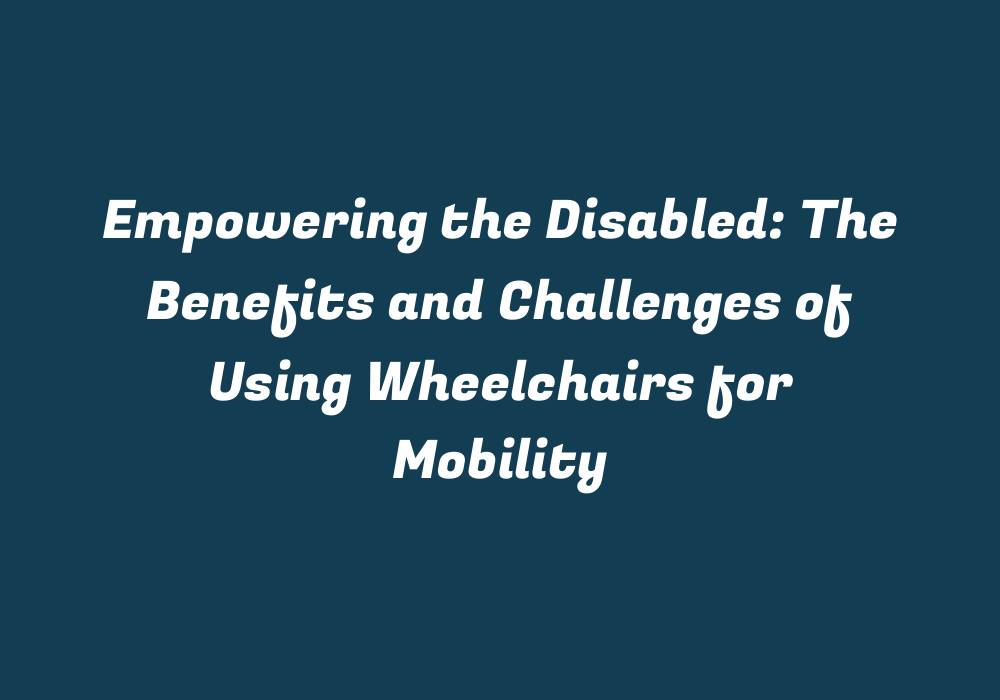Empowering the Disabled: The Benefits and Challenges of Using Wheelchairs for Mobility
The use of wheelchairs by disabled individuals has evolved significantly over time, providing them with enhanced mobility, improved independence, and countless benefits. Nonetheless, using a wheelchair does come with its share of challenges that need to be addressed. This article will discuss the key aspects of utilizing wheelchairs for mobility in relation to both the positive impacts and encountered difficulties.
Benefits
Improved Mobility: Perhaps the most crucial aspect of using a wheelchair is that it enhances the physical movement of disabled individuals. Wheelchairs provide an accessible mode of transportation, allowing users to navigate various environments with greater ease and comfort. They also allow users to participate in social activities, such as attending events or visiting friends, that might not have been possible otherwise.
Independence and Self-Sufficiency: Wheelchairs empower their users by promoting self-sufficiency and independence. With the use of a wheelchair, individuals can perform daily tasks without relying on others’ assistance as much as they might need otherwise. This fosters a sense of personal accomplishment, which is vital for their overall wellbeing.
Increased Accessibility: One of the key advantages of using wheelchairs is that they make public spaces more accessible to disabled individuals. For instance, wheelchair-friendly buildings, transportation systems, and events facilitate movement, ensuring people with disabilities can participate in various activities as much as they desire.
Challenges
Stigma and Social Perception: Despite the numerous benefits of using wheelchairs, disabled individuals often face stigmatization and negative social perceptions. Some may view them with pity or assume that their disability is a hindrance to personal achievements. It is essential for society to address these misconceptions to create an inclusive environment for people with disabilities.
Physical Challenges: While wheelchairs provide mobility, they also come with specific challenges related to maintaining one’s physical well-being. Sitting in a fixed position for extended periods can lead to issues such as pressure sores, weakened muscles, and limited flexibility. Additionally, navigating rough terrain or climbing steep inclines may be difficult, necessitating the use of additional mobility devices or support from others.
Transportation Limitations: While wheelchairs facilitate movement, they can still face transportation-related challenges. Accessing public transportation systems like buses and trains may require special accommodations or assistance from attendants. In some cases, private vehicles may not have adequate space to transport the user’s wheelchair, resulting in inconvenience or dependence on others for transport.
Addressing Challenges and Promoting Inclusivity
Educating Society: A crucial step towards inclusiveness is to promote awareness and understanding among the general public about the benefits of using wheelchairs for mobility. Educational programs, workshops, or online resources can be utilized to discuss the advantages, challenges faced by individuals with disabilities, and ways to create a more inclusive environment.
Incorporating Accessibility in Design: Architects, designers, and engineers should strive to incorporate wheelchair accessibility into building designs and public infrastructure. This includes providing ample space for wheelchair maneuverability, ensuring accessible entrances and restrooms, and creating an environment that is both functional and inclusive.
Encouraging Physical Activity: To counteract the physical challenges associated with using a wheelchair, promoting regular exercise and movement among users is vital. This can involve adopting a variety of exercises, such as resistance training, stretching, and aerobic activities that cater to individual needs and preferences. This will help maintain overall wellness and improve mobility.
Enhancing Accessibility in Transportation: Public transit systems should be made more accessible for wheelchair users by providing specialized vehicles or offering assistance during boarding and disembarking. Private vehicle owners should also consider installing ramps, adapting the interior to accommodate wheelchairs, or utilizing alternative transportation methods that facilitate inclusion.
Fostering Independence and Self-Reliance: By promoting self-reliance and independence among disabled individuals, they can build resilience and increase their overall quality of life. Encouraging personal growth and development will enable them to thrive in a more inclusive environment.
Conclusion
In conclusion, the use of wheelchairs for mobility offers numerous benefits to disabled individuals, such as enhanced independence and greater accessibility. However, several challenges remain that must be addressed for an all-inclusive society. By educating society, promoting inclusiveness in design and transportation, addressing physical challenges through exercise, and fostering independence, it is possible to create a more accessible world for people with disabilities using wheelchairs for mobility.
